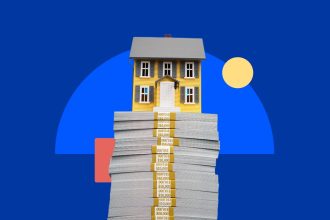Hill Street Studios/Getty Images
Key takeaways
- The FHA streamline refinance program makes it easier and cheaper for borrowers with FHA loans to refinance at lower rates.
- There are two types of FHA streamline refinances: non-credit qualifying and credit-qualifying. The former has no credit check.
- To be eligible for an FHA streamline refinance, the borrower must get a net tangible benefit, like a lower interest rate or a fixed rate.
- However, you can only refinance a current FHA mortgage, and only the amount of its current outstanding balance.
The FHA streamline refinance program makes it quicker and cheaper for borrowers who have a Federal Housing Administration-insured mortgage to refinance their loans at lower rates. FHA streamline refinances are typically easier to get than traditional refinances, so those undergoing some form of hardship might want to consider one. But they do have some important limitations, too.
Here’s what to know about getting an FHA streamline refi.
What is an FHA streamline refinance?
An FHA streamline refinance is a type of refinance loan available to FHA loan borrowers. As with any refinance, it involves taking out a new mortgage that you use to pay off your current one. It’s called a streamline refinance because the process of applying for the loan is much simpler than that of a standard refinance. It typically doesn’t require a home appraisal, for example.
How does an FHA streamline refinance work?
The FHA streamline program is divided into non-credit qualifying and credit-qualifying refinances. Both types are designed to lower the monthly principal and interest payments on a mortgage insured by the FHA.
Credit-qualifying streamline refinances require the lender to verify your income, check your credit and confirm your debt-to-income ratio. The FHA requires lenders to consider doing a credit-qualifying streamline in certain cases, including when the refinance would reduce the mortgage payment by more than 20 percent.
Those verification requirements don’t apply to non-credit qualifying refinances; the lender can help you refinance without meeting them. However, though the FHA doesn’t require a credit check, the lender you work with might still pull your credit report.
The FHA streamline program allows you to refinance even if you have an underwater mortgage — that is, you owe more on the home than it’s currently worth.
FHA streamline eligibility guidelines
The FHA streamline refinance program has more relaxed lending guidelines than traditional refinances when it comes to an appraisal, credit check and income verification. Yet it still imposes a number of eligibility requirements. The requirements can vary by lender, but here are the minimum standards.
1. You must refinance an FHA loan
This is the primary rule. In order to take advantage of the FHA streamline program, you must already have an FHA-insured mortgage.
2. You must receive a ‘net tangible benefit’
It’s only possible to do an FHA streamline refinance if it results in what the FHA calls a “net tangible benefit” for the borrower. These net tangible benefits include:
- At least a .5 percent reduction in your fixed-rate mortgage payment (including the mortgage insurance premium)
- Changing from an adjustable-rate mortgage (ARM) to a fixed-rate mortgage
- Shortening the loan term or extending it (to lower payments)
ARM streamline refinances have other specific requirements, as well. If you’d like to streamline refinance a one-year ARM to a fixed-rate loan, for example, the new interest rate can’t be more than two percentage points higher than the current ARM rate. The inverse is also true: If you’re refinancing a fixed-rate loan to a one-year ARM, the new rate must be at least two percentage points lower than the fixed rate.
3. You can only apply after a waiting period
You can’t apply for a streamline refinance immediately after closing your FHA loan. You’ll need to wait until:
- You’ve made at least six on-time payments
- Six months have passed since your first payment due date
- It’s been 210 days since your FHA loan closed
4. You must have a history of on-time payments
If your FHA loan is less than a year old, you’ll need to have made all of your monthly payments on time. If you’ve had your mortgage for more than a year, you’re allowed one 30-day late payment in the past 6 months — but, you must have made all mortgage payments on time for the three months prior to applying for the refinance.
5. You must pay mortgage insurance premiums
Like all FHA loans, you’ll pay mortgage insurance premiums (MIP) on an FHA streamline refinance. This means another upfront MIP, plus annual MIPs, at the following rates:
- Upfront MIP: 1.75 percent of the loan amount
- Annual MIP: Varies based on loan amount, LTV ratio and loan term, between 0.15 percent and 0.75 percent
Depending on when you got your initial FHA loan, you might be able to get a portion of the upfront MIP refunded when you refinance. The longer it’s been, the lower the refund. This refund could help you pay the MIP on the new loan.
Pros and cons of FHA streamline refinances
Pros
- No credit check: Having a low credit score typically won’t keep you from refinancing.
- No income verification: Unlike with a conventional refi, you won’t need to prove your income. That saves you some paperwork.
- No appraisal: The refinance loan amount is determined by what you owe on your current mortgage, not your home’s current value. That can be very beneficial for borrowers in a negative equity situation.
- Faster time to close: Because they don’t require a lengthy underwriting process, streamline refis fund you relatively quickly.
Cons
- Limited to FHA borrowers: If you don’t have an FHA loan now, you won’t qualify for this program. It’s not open to borrowers with a conventional or other type of mortgage.
- Strict rules: To qualify, the new loan must have a “net tangible benefit” to you as the borrower — like a rate drop of a certain amount.
- More mortgage insurance: You’ll have to pay the upfront mortgage insurance premium (MIP) again.
- No extra cash: You can’t do a cash-out refinance within the streamline program. Your new loan size is limited to the outstanding balance of your old mortgage.
What are FHA streamline refinance rates today?
FHA refinance rates are usually competitive with the refinance rates for other types of loans. You can use a mortgage refinance calculator to see how lowering your rate or shortening or lengthening your loan term would impact your mortgage payment and total interest.
How to apply for an FHA streamline refinance
- Check your credit. Any time you apply for a new loan, it’s smart to check your credit reports and scores. Although the FHA allows lenders to forgo a credit pull on non-credit qualifying streamline refinances, some lenders might still do one. If your credit could use some work, you’ll have time to take steps to improve your score, which raises your chances of a better rate.
- Find an FHA-approved lender. While you could go back to your current FHA lender, it pays to shop around, as rates vary from one lender to another. Many types of lenders offer FHA loans, including streamlines. Here are some of Bankrate’s picks for best FHA lenders.
- Prepare for the application. Although you won’t need to provide as many documents for an FHA streamline refinance, you’ll still need to furnish some details about your mortgage and financial situation. This includes information like your current mortgage statement and homeowners insurance policy.
FAQ about FHA streamline refis
Additional reporting by Mia Taylor
Read the full article here
















